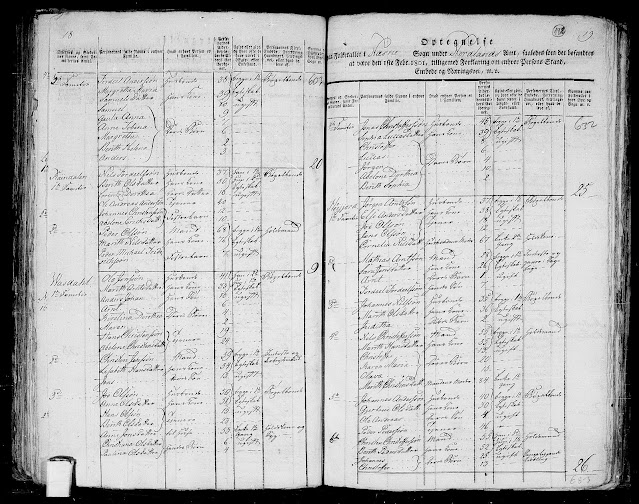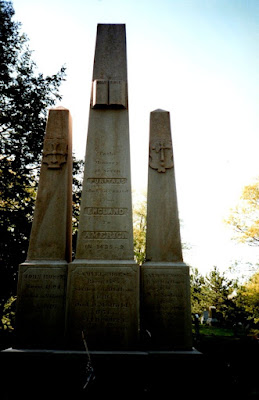My paternal line Bardahl ancestors hailed from quite far up the west coast of Norway in the Hemnes/Nesna area of Nordland. DNA matches from that branch of my family are few. Genealogical records from there also often seem sparse and difficult to access. When I visited the Chester Fritz Library to review other farm books for my Norwegian ancestors, none were available for Nordland.
Finding some of my Nordlanders in the 1801 Norwegian census confirmed some of what I had already found while providing one tantalizing possible addition to my tree.
 |
| 1801 census of Hellesvigen Farm, Hemnes, Nordland, Norway |
Lars Joensen (1760-1845) and Martith Christophersdatter (1768-1848) were my paternal grandfather's paternal great grandparents. (Lars was the conduit of the Y chromosome that my brothers and nephew have inherited.)
Seven families were living on the Hellesvigen farm in 1801. Lars and Marith were the 5th family listed, along with their sons Hans Christian Larsen who was 4 and my ancestor Joen Christian Larsen who was just 1. There was also a daughter Bereth Larsdatter who was 5. Then there is a grouping of three unmarried adults who were servants/workers - leading me to wonder how my simple farm folk could afford and find work for 3 hired workers? But that isn't the puzzle. The puzzle is the final person listed for their farm - 67 year-old widow Sara Andersdatter. Who was Sara Andersdatter? Might she be the mother of Lars or of Marith and thereby push my tree back another generation? Or was she perhaps related to someone else on the Hellesvigen farm?
With the patronymic naming system in Norway at that time. Sara would have retained the Andersdatter name for life based on her father's first name having been Anders. Any of her siblings would be either Andersens or Andersdatters.
I recognize that my limited knowledge of the Norwegian language and the difficulty in deciphering the handwriting might make it very easy for me to miss a clue. I believe all it says beside her age is that she is a widow after one marriage.
This seemed like an opportunity to try to research the FAN club (friends, associates, neighbours) to see if I could find answers. What could be learned from investigating other people mentioned in this census or other available records?
Time Waster Alert: You might wish to jump right to the Conclusion in the last paragraph rather than travel with me along the long convoluted process I undertook trying to find more about Sara Andersdatter.
Hypothesis 1: Sara Anderson is the mother of Lars Joensen. This seems the likeliest possibility given that she is a widow living in his household in the 1801 census. Searching for an appropriately timed and placed marriage of a Sara Andersdatter marrying someone with the first name of Joen (because their son is named Lars Joensen) yielded no results. That does not, however, mean this possibility can be discounted.
Hypothesis 2: Sara Andersdatter is the mother of Marith Christophersdatter. A search did yield a possible marriage in the right time and place between a man with first name Christopher and a woman named Sara Andersdatter:
 |
| 7 November 1767 marriage Christopher Pedersen and Sara Andersdatter, Hemnes Kirkebok |
Unfortunately, this record is quite bare-bones, not containing any additional information about bride and groom as is often given in later Norwegian records. No other records for this couple have been located.
One obvious step was to check the other families listed on the Hellesvigen farm in that 1801 census to see what names might lead to more insights into any connection between Sarah Andersdatter and either Lars or Marith.
 |
| 1801 Norwegian census for Hellesvigen Farm Families 1-3 |
The first family was that of 48 year-old Erick Jorgen Olsen and his 40 year-old wife Ane Kristina Jacobsdatter. Aside from their Eriksen/Eriksdatter children, there were two other Olsen men, Kristina Joensdatter (age 26, possibly a sister to Lars?) and a young Iversen child. (Yes, of course I searched to see if I could find a birth record for Kristina Joesndatter to locate her family but no luck.)
The second family was the 70 year-old widow Jacobsdatter, 55 year-old Andreas Thomsen and his 48 year-old wife Maren Michelsdatter and their daughter Thomina Andreasdatter.
The third family included 42 year-old Hans Olsen and his wife Berith Jonsdatter, and their 4 Hansen/Hansdatter children. Others on the farm were Jensen, Enersen, Hansdatter and Nilsdatter and two people in their 70's - Pernille Pedersdatter and Jens Iversen.
The fourth family Hans Gregussen (?), his Jacobsdatter wife and two Hansen children,
 |
| 1801 Norwegian census for Hellesvigen Farm families 6 and 7 |
The sixth family included 62 year-old Marten Jacobsen and his wife Karen Peersdatter and all their Martensen/Martensdatter children.
The final family consisted of 53 year-old Peer Thorssensen, his wife Guri Pedersdatter and their Peersen/Peersdatter children.
Nothing from the list of neighbours in the 1801 census stood out as being a connection to other members of the family of Sara Andersdatter. I did not undertake the overwhelming task of finding parents for each of the heads of all the families to see if Sara might turn up as a mother to another of the farmers or their wives.
Where else did Sara appear in the records? Searches were not particularly helpful. There was a Sara Andersdatter who was witness to the baptism of another ancestor of mine, Olina Maria Olsdatter (1806-1883). Olina would grow up to marry Joen Christian Larsen, the one year-old son of Lars Joensen listed above in the same household as Sara in the 1801 census.
 |
| 1806 baptism of Olina Maria Olsdatter includes witness Sara Andersdatter of Høijorden |
Olina's parents: Ole Jonssen of Vasdal and Marith Arntsdatter. Other witnesses to Olina's birth appear to be (something like) Else Hansdatter of Høijorden, Anne Jacobsdatter of Vasdal and Mathias and Jorgen Arntsen of Høijorden. If this witness is the same Sara Andersdatter, why would she now be affiliated with the Høijorden farm rather than Hellesvigen? This led to to the next hypothesis:
Hypothesis 3 : Sara Andersdatter may have originally come from a family on Høijorden farm in which case she might have a brother of patronymic name Andersen living there at the time of the 1801 census.
The Høijorden farm from the same 1801 census appears below on the right-hand page.
 |
| Høijorden farm in Nordland, Norway 1801 Census |
[To demonstrate the interconnectedness of the families in this community, two farms were located near one another and show up on the same image - the Wasdahl/Vasdal farm on the left and the Høijorden farm on the right. For Vasdal there were four families listed, including that of my ancestors Ole Jonsen and Marith Arntstdatter at Farm 1. (This is the family that Olina would be born into 5 years later.) None of the patronymics there included any Andersens or Andersdatters.]For Høijorden, six families were listed. The first family was that of Jorgen Artnsen (known to be a brother to Marith Arntsdatter and also listed as a witness to the baptism of his niece Olina above) and his wife Else Andersdatter age 38 (might she be the same woman who appeared to be called Else Hansdatter in that baptism record? For that matter, might the clerk have transposed the patronymic names of the two female witnesses and it should have actually been Sara Hansdatter and Else Andersdatter as listed in the census for the two wives? I believe that is most likely what happened and that the Sara Andersdatter witnessing Olina's baptism is NOT the same woman I am trying to find.) In any event, Else Andersdatter would be too young to be a sister to 67 year-old Sara Andersdatter. Living with them was Cornelia Nilsdatter, the same age as Sara Andersdatter; Cornelia was the widow of Arnt Jorgensen and she was Jorgen and Marith's mother.
The next Høijorden family was that of Mathias Arntsen and his wife Sara Jensdatter; Mathias was another brother of Jorgen Arntsen and Marith Arntsdatter and he also had been listed as a witness for the baptism of his niece Olina.
In the end, I don't believe my subject Sarah Andersdatter had anything to do with the Høijorden farm at all.
Hypothesis 4: Sara Andersdatter is completely unrelated to my family and is an associate, friend servant of the family. She is not grouped with the servants and is older than servants generally were in Norway at the time. But, if not related, where did she come from and why?
Future research should include locating a copy of the relevant farm book for Hellesvigen, Hemnes, Nordland. I have spent many fruitless hours browsing through chronological church records for many of the likeliest years to find birth and death records for Sara Andersdatter as well as for Lars Joensen and Marith Christophersdatter; with perseverance, additional browsing might yet bring something to light. Sadly, there are no additional censuses that might have included Sara Andersdatter in her younger years.
Conclusion: So who was Sara Andersdatter? I have failed to find an answer to that question among her neighbours and associates. I still believe she was most likely the mother of Marith or possibly of Lars. I wish I had attempted an easier project for my FAN club investigation, not one with patronymic names and a language I have not mastered. I did not find any concrete evidence to fit Sara Andersdatter into my family tree -- or to rule out that possibility. For me "FAN" club in this case might be an acronym for "Found Almost Nothing!".































